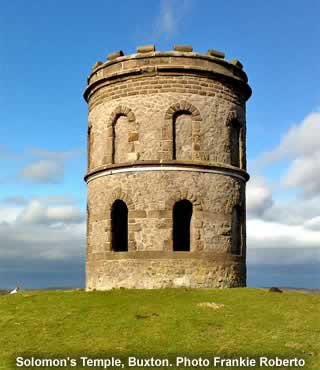Buxton |
|
 |
|||
Britain > Peak District > Buxton |
||
The highest English town, nestled amongst the hills of Derbyshire |
||
Buxton, nestled amongst the hills of Derbyshire, is the highest English town above sea level. The town isn't actually within the boundaries of the Peak District, but it nevertheless acts as a transport hub for the National Park. Various bus and train routes connect to towns and villages throughout the area, as well as to the surrounding cities of the Midlands. |
||
The town's name is most readily connected with Buxton's bottled water, which is sold all over the globe. This very same mineral water, which emerges from a geothermal spring over 1.5 kilometres below the surface of the planet, led to Buxton becoming known as an important spa town. The thermal baths here were frequented by people who were stressed, or unwell, as the mineral water was said to have many health-giving properties. Today, the baths have been closed, but the water is still flowing. If you visit Buxton, though, you don't need to buy it from a shop. Instead, you can head to St. Anne's Well in the centre of town, and help yourself, for free. |
||
Another of Buxton's most famous places is also situated underground. It's a huge limestone cave called Poole's Cavern, which was named after a criminal who lived here in the 15th century. He apparently used the cave as a hideout, emerging periodically to relieve passers-by of their valuables. It has been open for public viewing since the 1850s, when it was officially opened by the Duke of Devonshire. Over 300m of the cave network is open to the public, including several different chambers. Poole's Cavern extends further than this, but as of yet, much remains unexplored. |
||
Not far from here is a Buxton landmark that was, by contrast, built by human hands. This is Solomon's Temple, a tower that sits at the summit of a prominent hill. This structure is what's known as a "folly", which means that it serves no real practical function. Instead, it exists simply for aesthetic reasons, and as such, it is one of Buxton's most recognisable buildings. Solomon's Temple offers views of the town, and of the surrounding countryside, that can stretch for over 20 kilometres. |
||
There are also some very notable pieces of architecture within the town itself. The Crescent is a semi-circular terrace of houses that was modelled after the famous Royal Crescent, in the city of Bath. |
||
An even more recognisable building is the Opera House. It was designed in the very early 1900s by Frank Matcham, an architect that was also responsible for several of London's most prestigious theatres, such as the Palladium. The Opera House is the home of two large annual festivals. The first is the simply named "Buxton Festival", which has grown into one of the biggest celebrations of operatic music in the UK. It features a range of fringe events, which are often seen as a warm-up for the larger Edinburgh Festival. The second of the Opera House's major events is the International Gilbert and Sullivan, which remember the work of the two famous 19th century composers. The festival is centred on a competition between several groups of amateur contestants, who attempt to deliver the best performance of one of Gilbert and Sullivan's operas. |
||
Directly next to the Opera House are the Pavilion Gardens, a 23-acre area of beautiful flowers, trees, and lakes. It recently enjoyed a 4.5 million restoration, which saw it converted back to its Victorian roots. The gardens are a favourite of residents and tourists alike, with around half a million visitors a year. |
||
|
||
Buxton Tourist Information Centre, The Crescent, Buxton, SK17 6BQ. Tel: 01298 25106 |
||
Poole Cavern is open daily, 10am to 4pm. Entry costs around £8 for adults, £5 children. Green Lane, Buxton, Derbyshire SK17 9DH. Tel: 01298 26978 |
||
Pavilion Gardens is open daily, 9.30am to 5pm. Entry is FREE. St. John's Road, Buxton, Derbyshire, SK17 6BE. Tel: 01298 23114 |
||
|
Pocket Britain is optimised for use on a smartphone or tablet with internet access. All content is subject to copyright. All reasonable methods have been used to ensure information supplied is accurate at the time of publication. However, it is advisable to check information before relying on it. Privacy Policy |